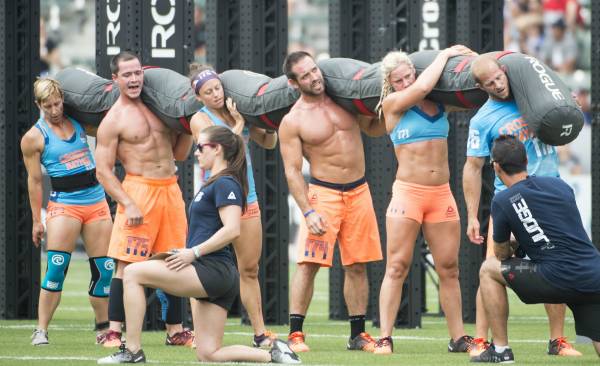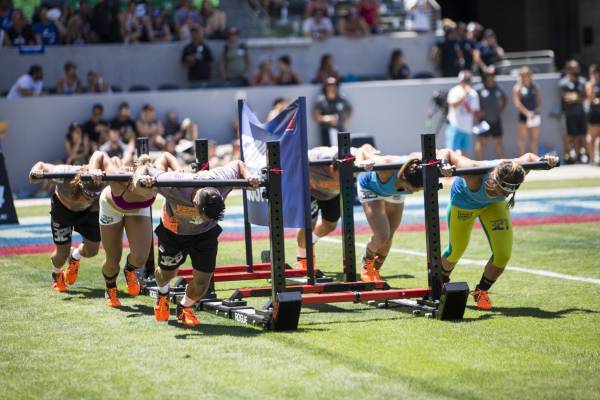On the 12th of November, 2015, two-time CrossFit Games competitor and GRID athlete with the Boston Iron Lindy Barber announced she was moving to Tennessee to join Rich Froning’s team, CrossFit Mayhem Freedom.
Lindy Barber’s announcement as the newest member of team CrossFit Mayhem Freedom via Instagram.
With this announcement, the official era of the CrossFit Games dream team was born. Dream teams have existed for years, but prior to this, it was always a surreptitious affair. No one spoke of it, even though everybody knew it was going on. Now, much like the relocation of individuals to find an advantageous region to qualify for the Games, dream-teaming is breaking into the open and will surely become part of the competition landscape.
A Brief History of Team Competition
- 2009: For a team to participate in the CrossFit Games, all they had to do was hop on a plane and fly to the Ranch on the weekend it was being held.
- 2010: Teams (and individuals) had to participate in the Sectionals process in order to qualify for the Games. The Affiliate Cup was merely an annex of the individual competition (much like the Masters competition is now), and not much attention was paid to the formation of teams. The idea of creating super teams had not yet crystallised because team participation was in its infancy.
- 2011: The online Open was introduced. Teams qualified just like individuals – Open, Regionals, Games. By this time, although the rule book did not address it, dream teams began to form. Some teams found they could be a much stronger unit by assimilating athletes from other local gyms. It was the Wild West back then – everyone was trying to figure out the landscape, and few people gave the idea of super teams much attention because everything was so new.
- 2012: The powers that be at CFHQ began to hear rumblings of dream teams. They rewrote the rules to insist that teams be comprised of athletes who train primarily at the subject box.
- 2013: CrossFit was cracking down. The power of social media was such that as soon as a Regionals team was registered and appeared on the Games website, anything that looked suspicious was immediately looked into. One team member might be a trainer at a box that was, in some cases, 200 miles away. Complaints would go out on social media and to HQ. In one case, that of Brick CrossFit, the team members were disqualified. Since then, numerous teams have been disqualified for the same reason. Most never made the front page because the team simply disappeared.
Following 2013, the new lesson was it was difficult to hide your ringers. Social media was like that kid in your Year 4 class who went and told the teacher the cool kids were playing with a lighter in the toilets. Super teams had to find another way.

Team CrossFit Mayhem Freedom during the Worm Finale event at the 2015 CrossFit Games.
Enter CrossFit Conjugate
CrossFit Conjugate brilliantly addressed the issue in 2014 by assembling a dream team with nearly spotless methods (I will explain the “nearly” part shortly). A year before, CrossFit Conjugate was a brand new affiliate whose Regionals team was disqualified on day one of the Regionals for being unable to complete the requisite number of muscle ups. Yet they rocketed to second place in the world one year later. Quality coaching and programming, you may ask? Not really. You can’t grow a world-class team organically in a single year. Rather, through a so-called serendipitous series of relocations and subtle recruiting, Conjugate assembled a world class roster of athletes:
- Mark Nelson and Hunter Britt were already members of that box. Nelson was a member of the 2013 team. Britt was, and is, an up-and-coming wunderkind whose name you will hear in the future.
- Sam and Jennie Dancer, owners of Q-town CrossFit in Quincy, Illinois, moved to Cincinnati to take up a coach-in-residence position.
- Lindsey Kelly relocated from Chicago about the same time as the Dancers.
- Melissa Doss, a long-time member of a local box in Kentucky about 45 minutes away, was the question mark. There is no question that she trained and coached at CrossFit The Tracks, but she had to carefully create a paper trail of participation at CrossFit Conjugate’s physical location in order to justify her place on the team.
CrossFit Conjugate was true to the letter of the law. In theory, as long as a team meets the rule book requirements, there is not a damn thing wrong with assembling its component parts from around the country.
However, it takes a hell of a commitment to relocate from Quincy, Illinois to Cincinnati, Ohio for a year just to be part of a CrossFit team. It shows just how far some gyms will go in order to make it to the Games. Plenty of teams have been disqualified in the past few years for rule violations. And then there are the dozens of teams that were never caught, despite the relocations, the bogus Facebook “check ins,” and the workout logs. All to make it first to Regionals and then possibly, the Games. But for what exactly? How much value does the Affiliate Cup really hold?
The Future of CrossFit Team Competition
Apparently, the answer is a lot. Why else would Lindy Barber, a fine athlete in her own right, make the 180-mile move from Louisville to Cookeville, Tennessee? I can only assume that Froning actively recruited her, which means he is piecing together his 2016 hand-picked team. As if we didn’t already know this, Froning loves to win.
But Froning is hardly alone, and oddly, there is little to win – some money, a bit of residual notoriety, but that’s about it. Nevertheless, the desire to make it to the big show is huge.
The only difference between the Conjugate method (see what I did there?) of 2014 and the Mayhem method of 2016 is that Mayhem openly admits their assembly of a super team by way of Barber’s post. Conjugate had to operate in the “Don’t ask, don’t tell” era of pretending it was all staffing-related and happenstance.

Team Verdant Green during the Big Bob Drag Race event at the 2015 CrossFit Games.
We’ve entered a new era of the Affiliate Cup. I suspect a flood of similar announcements will follow. Right or wrong, it’s the landscape of the team side of CrossFit now. There will always be gyms like Diablo CrossFit, which prides itself in its teams being homegrown and home-trained. But the genie is now out of the bottle, and with Barber’s announcement, CrossFit gyms across the globe will likely now begin a heavy recruiting effort. The original purpose of the Affiliate Cup, to “Find the Fittest Gym,” no longer applies. The spirit of the law was corrupted for a while, and now the letter of the law is, too.
And that’s fine. It’s merely the reality of the way the sport has morphed. However, it certainly makes the team side of the Games less appealing, at least in my opinion. It’s tantamount to PEDS being legalised and all the top competitors admitting they are taking them. Suddenly, the achievement is less about fitness, programming, skill, and community, and more about who’s the best puppeteer.
You’ll Also Enjoy
- I Have a Dream (Team): When Winning Is The Only Thing That Matters
- The Moment Grid Became A Sport
- The CrossFit Games is Broken, Part 3: Team Competition and Leaderboard Shenanigans
- New on Breaking Muscle UK Today
Photo 1 courtesy of Lindy Barber’s Instagram.
Photos 2 & 3 courtesy of CrossFit Inc.






